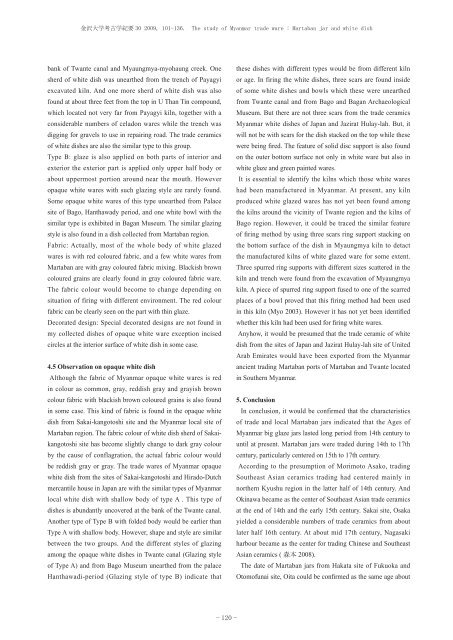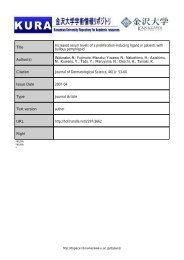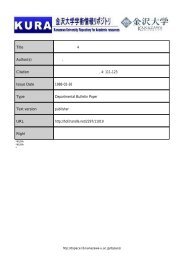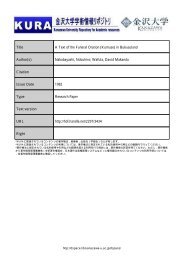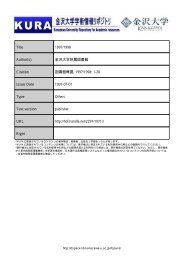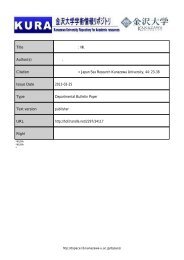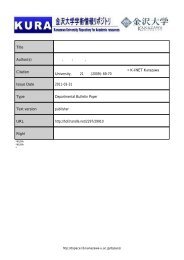Title The Study on Myanmar trade ware:Martaban Jar and ... - 金沢大学
Title The Study on Myanmar trade ware:Martaban Jar and ... - 金沢大学
Title The Study on Myanmar trade ware:Martaban Jar and ... - 金沢大学
You also want an ePaper? Increase the reach of your titles
YUMPU automatically turns print PDFs into web optimized ePapers that Google loves.
<strong>金沢大学</strong>考古学紀要 30 2009, 101-136. <str<strong>on</strong>g>The</str<strong>on</strong>g> study of <strong>Myanmar</strong> <strong>trade</strong> <strong>ware</strong> : <strong>Martaban</strong> jar <strong>and</strong> white dish<br />
bank of Twante canal <strong>and</strong> Myaungmya-myohaung creek. One<br />
sherd of white dish was unearthed from the trench of Payagyi<br />
excavated kiln. And <strong>on</strong>e more sherd of white dish was also<br />
found at about three feet from the top in U Than Tin compound,<br />
which located not very far from Payagyi kiln, together with a<br />
c<strong>on</strong>siderable numbers of celad<strong>on</strong> <strong>ware</strong>s while the trench was<br />
digging for gravels to use in repairing road. <str<strong>on</strong>g>The</str<strong>on</strong>g> <strong>trade</strong> ceramics<br />
of white dishes are also the similar type to this group.<br />
Type B: glaze is also applied <strong>on</strong> both parts of interior <strong>and</strong><br />
exterior the exterior part is applied <strong>on</strong>ly upper half body or<br />
about uppermost porti<strong>on</strong> around near the mouth. However<br />
opaque white <strong>ware</strong>s with such glazing style are rarely found.<br />
Some opaque white <strong>ware</strong>s of this type unearthed from Palace<br />
site of Bago, Hanthawady period, <strong>and</strong> <strong>on</strong>e white bowl with the<br />
similar type is exhibited in Bagan Museum. <str<strong>on</strong>g>The</str<strong>on</strong>g> similar glazing<br />
style is also found in a dish collected from <strong>Martaban</strong> regi<strong>on</strong>.<br />
Fabric: Actually, most of the whole body of white glazed<br />
<strong>ware</strong>s is with red coloured fabric, <strong>and</strong> a few white <strong>ware</strong>s from<br />
<strong>Martaban</strong> are with gray coloured fabric mixing. Blackish brown<br />
coloured grains are clearly found in gray coloured fabric <strong>ware</strong>.<br />
<str<strong>on</strong>g>The</str<strong>on</strong>g> fabric colour would become to change depending <strong>on</strong><br />
situati<strong>on</strong> of firing with different envir<strong>on</strong>ment. <str<strong>on</strong>g>The</str<strong>on</strong>g> red colour<br />
fabric can be clearly seen <strong>on</strong> the part with thin glaze.<br />
Decorated design: Special decorated designs are not found in<br />
my collected dishes of opaque white <strong>ware</strong> excepti<strong>on</strong> incised<br />
circles at the interior surface of white dish in some case.<br />
4.5 Observati<strong>on</strong> <strong>on</strong> opaque white dish<br />
Although the fabric of <strong>Myanmar</strong> opaque white <strong>ware</strong>s is red<br />
in colour as comm<strong>on</strong>, gray, reddish gray <strong>and</strong> grayish brown<br />
colour fabric with blackish brown coloured grains is also found<br />
in some case. This kind of fabric is found in the opaque white<br />
dish from Sakai-kangotoshi site <strong>and</strong> the <strong>Myanmar</strong> local site of<br />
<strong>Martaban</strong> regi<strong>on</strong>. <str<strong>on</strong>g>The</str<strong>on</strong>g> fabric colour of white dish sherd of Sakaikangotoshi<br />
site has become slightly change to dark gray colour<br />
by the cause of c<strong>on</strong>flagrati<strong>on</strong>, the actual fabric colour would<br />
be reddish gray or gray. <str<strong>on</strong>g>The</str<strong>on</strong>g> <strong>trade</strong> <strong>ware</strong>s of <strong>Myanmar</strong> opaque<br />
white dish from the sites of Sakai-kangotoshi <strong>and</strong> Hirado-Dutch<br />
mercantile house in Japan are with the similar types of <strong>Myanmar</strong><br />
local white dish with shallow body of type A . This type of<br />
dishes is abundantly uncovered at the bank of the Twante canal.<br />
Another type of Type B with folded body would be earlier than<br />
Type A with shallow body. However, shape <strong>and</strong> style are similar<br />
between the two groups. And the different styles of glazing<br />
am<strong>on</strong>g the opaque white dishes in Twante canal (Glazing style<br />
of Type A) <strong>and</strong> from Bago Museum unearthed from the palace<br />
Hanthawadi-period (Glazing style of type B) indicate that<br />
− 120 −<br />
these dishes with different types would be from different kiln<br />
or age. In firing the white dishes, three scars are found inside<br />
of some white dishes <strong>and</strong> bowls which these were unearthed<br />
from Twante canal <strong>and</strong> from Bago <strong>and</strong> Bagan Archaeological<br />
Museum. But there are not three scars from the <strong>trade</strong> ceramics<br />
<strong>Myanmar</strong> white dishes of Japan <strong>and</strong> Jazirat Hulay-lah. But, it<br />
will not be with scars for the dish stacked <strong>on</strong> the top while these<br />
were being fired. <str<strong>on</strong>g>The</str<strong>on</strong>g> feature of solid disc support is also found<br />
<strong>on</strong> the outer bottom surface not <strong>on</strong>ly in white <strong>ware</strong> but also in<br />
white glaze <strong>and</strong> green painted <strong>ware</strong>s.<br />
It is essential to identify the kilns which those white <strong>ware</strong>s<br />
had been manufactured in <strong>Myanmar</strong>. At present, any kiln<br />
produced white glazed <strong>ware</strong>s has not yet been found am<strong>on</strong>g<br />
the kilns around the vicinity of Twante regi<strong>on</strong> <strong>and</strong> the kilns of<br />
Bago regi<strong>on</strong>. However, it could be traced the similar feature<br />
of firing method by using three scars ring support stacking <strong>on</strong><br />
the bottom surface of the dish in Myaungmya kiln to detact<br />
the manufactured kilns of white glazed <strong>ware</strong> for some extent.<br />
Three spurred ring supports with different sizes scattered in the<br />
kiln <strong>and</strong> trench were found from the excavati<strong>on</strong> of Myaungmya<br />
kiln. A piece of spurred ring support fused to <strong>on</strong>e of the scarred<br />
places of a bowl proved that this firing method had been used<br />
in this kiln (Myo 2003). However it has not yet been identified<br />
whether this kiln had been used for firing white <strong>ware</strong>s.<br />
Anyhow, it would be presumed that the <strong>trade</strong> ceramic of white<br />
dish from the sites of Japan <strong>and</strong> Jazirat Hulay-lah site of United<br />
Arab Emirates would have been exported from the <strong>Myanmar</strong><br />
ancient trading <strong>Martaban</strong> ports of <strong>Martaban</strong> <strong>and</strong> Twante located<br />
in Southern <strong>Myanmar</strong>.<br />
5. C<strong>on</strong>clusi<strong>on</strong><br />
In c<strong>on</strong>clusi<strong>on</strong>, it would be c<strong>on</strong>firmed that the characteristics<br />
of <strong>trade</strong> <strong>and</strong> local <strong>Martaban</strong> jars indicated that the Ages of<br />
<strong>Myanmar</strong> big glaze jars lasted l<strong>on</strong>g period from 14th century to<br />
until at present. <strong>Martaban</strong> jars were <strong>trade</strong>d during 14th to 17th<br />
century, particularly centered <strong>on</strong> 15th to 17th century.<br />
According to the presumpti<strong>on</strong> of Morimoto Asako, trading<br />
Southeast Asian ceramics trading had centered mainly in<br />
northern Kyushu regi<strong>on</strong> in the latter half of 14th century. And<br />
Okinawa became as the center of Southeast Asian <strong>trade</strong> ceramics<br />
at the end of 14th <strong>and</strong> the early 15th century. Sakai site, Osaka<br />
yielded a c<strong>on</strong>siderable numbers of <strong>trade</strong> ceramics from about<br />
later half 16th century. At about mid 17th century, Nagasaki<br />
harbour became as the center for trading Chinese <strong>and</strong> Southeast<br />
Asian ceramics ( 森本 2008).<br />
<str<strong>on</strong>g>The</str<strong>on</strong>g> date of <strong>Martaban</strong> jars from Hakata site of Fukuoka <strong>and</strong><br />
Otomofunai site, Oita could be c<strong>on</strong>firmed as the same age about


